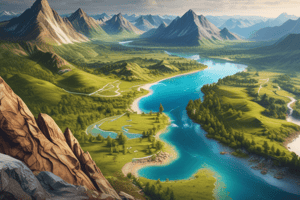Podcast
Questions and Answers
What does physical geography primarily focus on?
What does physical geography primarily focus on?
- Political boundaries
- Earth's physical features (correct)
- Social interactions
- Human-made structures
Which of the following is NOT a common landscape form discussed in the text?
Which of the following is NOT a common landscape form discussed in the text?
- Deserts (correct)
- Plains
- Valleys
- Hills
What physical processes shape landscapes?
What physical processes shape landscapes?
- Erosion, deposition, weathering (correct)
- Deforestation
- Urbanization
- Industrialization
What do weather and climate help us anticipate?
What do weather and climate help us anticipate?
What is the difference between weather and climate?
What is the difference between weather and climate?
Why is understanding the water cycle crucial for life on Earth?
Why is understanding the water cycle crucial for life on Earth?
What are the components of the water cycle?
What are the components of the water cycle?
Which method can be considered as a strategy for sustainable water management based on the text?
Which method can be considered as a strategy for sustainable water management based on the text?
What percentage of the Earth's surface is covered by oceans?
What percentage of the Earth's surface is covered by oceans?
What role do oceans play in supporting marine ecosystems?
What role do oceans play in supporting marine ecosystems?
What is a key benefit of studying natural hazards according to the text?
What is a key benefit of studying natural hazards according to the text?
What does GIS technology allow researchers to do in physical geography studies?
What does GIS technology allow researchers to do in physical geography studies?
Flashcards are hidden until you start studying
Study Notes
Physical Geography
Physical geography refers to the branch of geography that focuses on the study of Earth's physical features, including landscapes, ecosystems, atmospheric phenomena, and geological processes. This field seeks to understand the distribution of these features, their interactions, and the forces that shape them. Here, we delve deeper into various aspects of physical geography, providing insights into fundamental concepts and current trends.
Landscapes
Landscapes are complex systems comprising both abiotic and biotic factors. They are shaped by a variety of physical processes, such as erosion, deposition, weathering, and volcanic activity. Understanding these processes and the resulting landscape features is crucial for predicting environmental change and managing natural resources sustainably. Some common landscape forms include plains, hills, plateaus, valleys, basins, cliffs, coves, and islands.
Weather and Climate
Weather describes the day-to-day atmospheric conditions, while climate represents long-term patterns of temperature, precipitation, wind, humidity, and pressure. Studying weather and climate helps us anticipate extreme events like hurricanes, droughts, storms, and flooding. Additionally, it enables us to better understand historical climatic shifts and forecast future changes due to global warming.
Water Cycle
The water cycle plays a critical role in maintaining life on our planet. Its components include precipitation, evaporation, condensation, and runoff. By understanding the water cycle, we can develop strategies for sustainable water management, such as rainwater harvesting, recycling greywater, and improving irrigation systems.
Oceans
Oceans cover approximately 71% of the Earth's surface and play a vital role in regulating climate, nutrient cycling, carbon sequestration, and supporting marine ecosystems. Studying oceanography provides insight into ocean currents, waves, tides, seafloor mapping, and marine ecology, among other aspects.
Natural Hazards
Natural hazards pose significant risks to communities worldwide. These include earthquakes, tsunamis, tornadoes, hurricanes, floods, and wildfires. By studying natural hazards and their underlying causes, we can improve our ability to mitigate, prepare for, and respond to disasters effectively.
Geographical Information Systems (GIS)
GIS technology allows us to collect, store, analyze, manage, and visualize spatial information. Using GIS, researchers can analyze relationships between human activities and environmental variables, monitor ecosystem health, predict weather patterns, and plan sustainable infrastructure development.
In conclusion, physical geography offers valuable insights into our Earth's complex systems and processes. As our population continues to grow, understanding these dynamics becomes increasingly important for making informed decisions related to resource management, urban planning, disaster preparedness, and conservation efforts.
Studying That Suits You
Use AI to generate personalized quizzes and flashcards to suit your learning preferences.



